
The Bottom Line
Pros
- + DDR5/PCIe 5.0
- + 10Gbe networking
- + 2.5Gbe Wi-Fi
- + M-Vision touchscreen panel
Cons
- - Price
- - No USB4
- - No HDMI
- - No DisplayPort
Should you buy it?
AvoidConsiderShortlistBuyIntroduction, Specifications, and Pricing
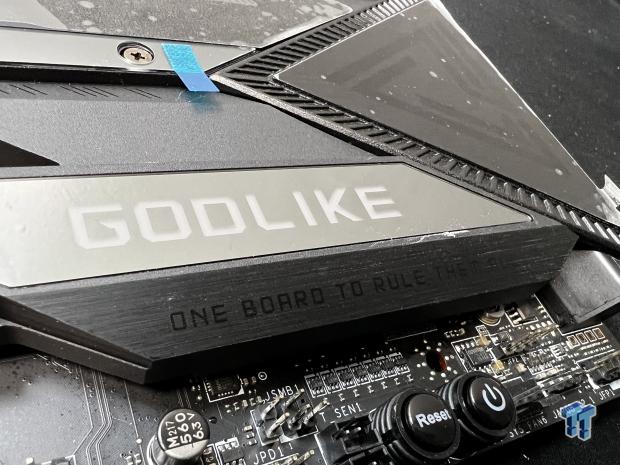
After several years now testing and reviewing motherboards, X670E gives me my first look at a GODLIKE motherboard. Coming off the MEG X670E ACE review, this board looks to take things up a notch with a better overall VRM, additional connectivity, and a more robust accessory kit. That being said, on paper, the GODLIKE has some interesting choices in connectivity and expansion that put it dangerously close to the ACE.
Off the bat, the GODLIKE, like all other X670E chipset platforms, is an AM5 motherboard, which gives us support for both PCIe 5.0 and DDR5. This particular model offers four slots, with the maximum capacity being 128GB and speeds ranging from 4400MHz to 6600MHz for those wanting to overclock.
Switching to expansion, the GODLIKE offers three PCIe 5.0 x16 slots. These operate in an x16/0/4 setup for single card setups, and for those using dual cards, you would move to an x8x8x4 configuration. On the storage side, we have four m.2 slots and these work with one slot pulling from the CPU at Gen5 while the other three pull from the chipset at Gen4. Legacy storage is available via eight SATA 6GBps connections.
Connectivity for this solution includes a total of fifteen USB 3.2. The breakdown includes seven USB 3.2 Gen2 in the type-A format on the rear I/O and another two USB 3.2 Gen2x2 using the type-C connector. Internal headers allow for the addition of six USB 3.2 and four USB 2.0 should your chassis support.
On the networking side, the GODLIKE offer both 2.5Gbe with the Intel i225 and 10Gbe via the Marvell AQC113 chipset. Audio is supported via the RTL4082 and ESS 9280DAC.
Pricing
The MSI MEG X670E GODLIKE price comes in at $1299.99 with a three-year warranty.

Packaging, Accessories, and Overview
Packaging and Accessories
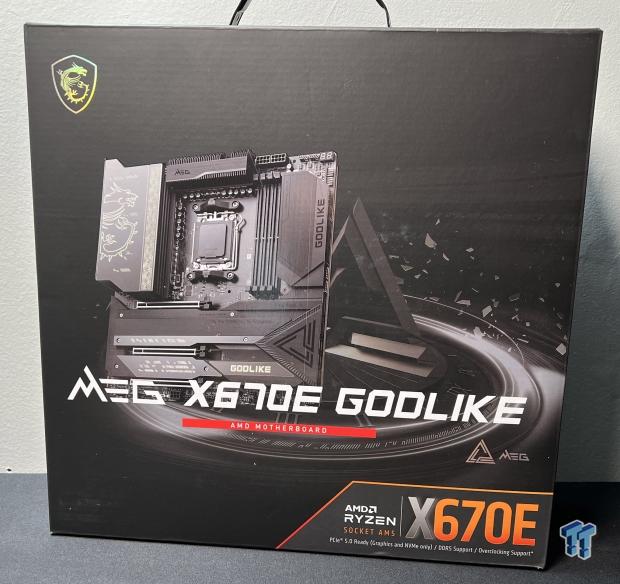
The GODLIKE offers rather basic packaging, including an image of the board on the front alongside appropriate branding and mention of the chipset CPU along the bottom.
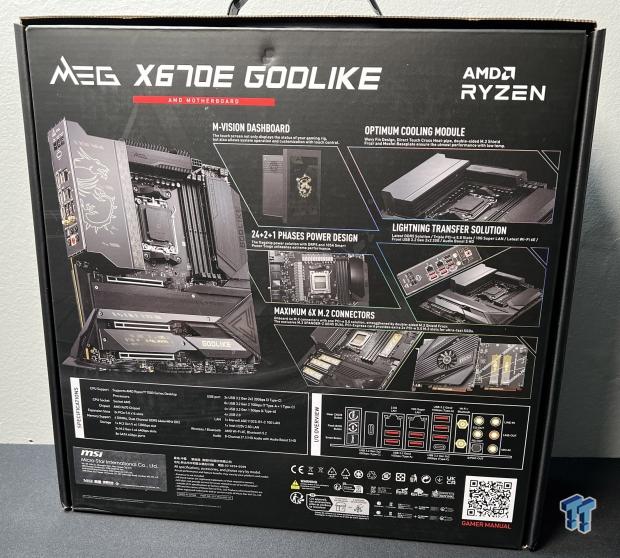
On the back, we get an image of the board to the left, with a ton of features being showcased on the right side and the port layout below.
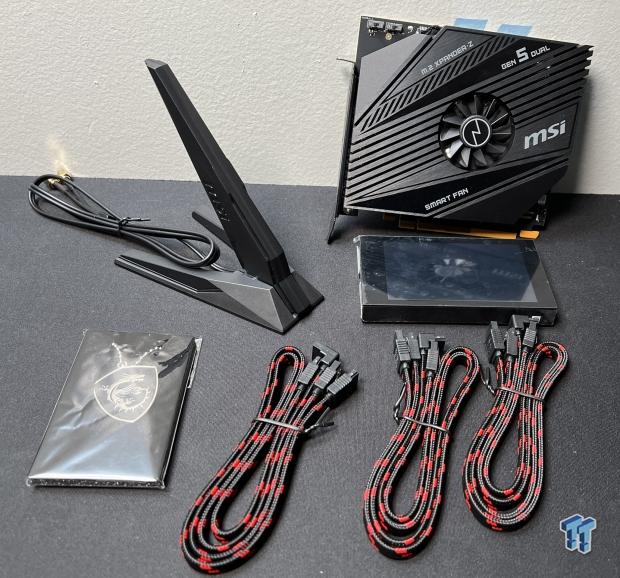
Included with the GODLIKE, we get premium SATA cables, a Wi-Fi antenna, and Gen5 AIC. The GODLIKE also comes with the M-Vision touchscreen panel.
Motherboard Overview
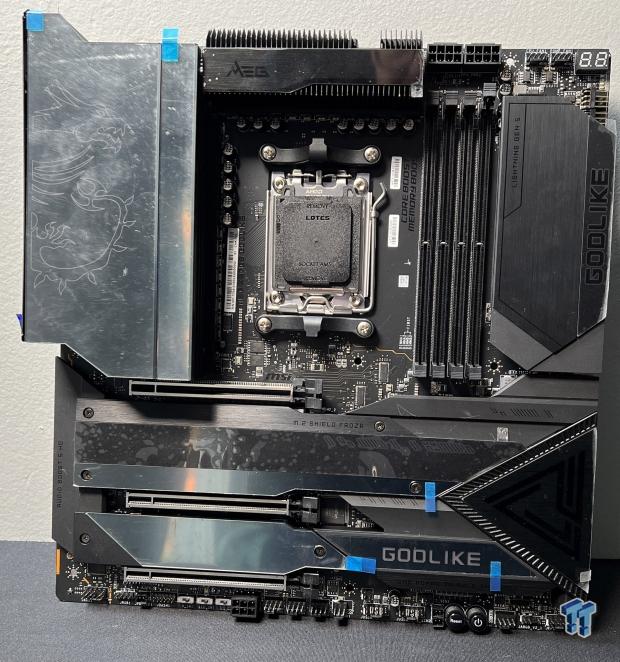
The GODLIKE offers plenty of mirrored surfaces, and we certainly will remember it's a GODLIKE platform with all of the branding put in place. That being said, the board does offer heatsink coverage for the entire VRM and chipset area, along with the m.2 connections.
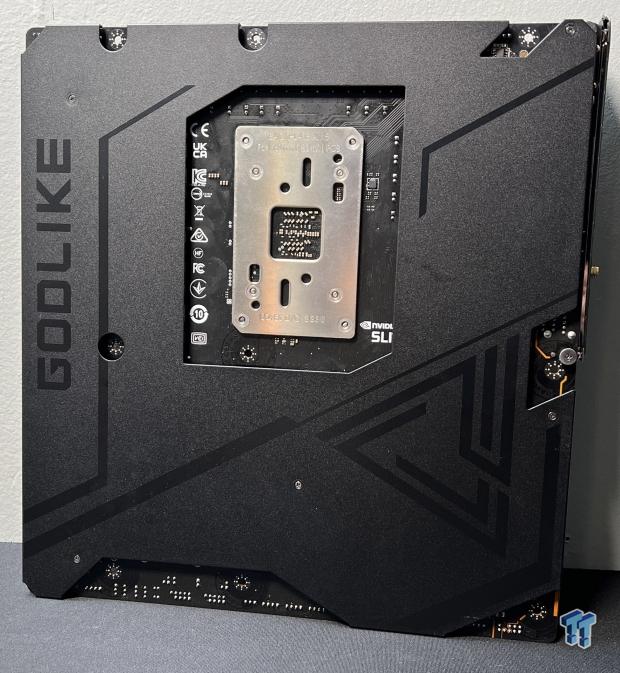
On the backside, we have a full backplate.
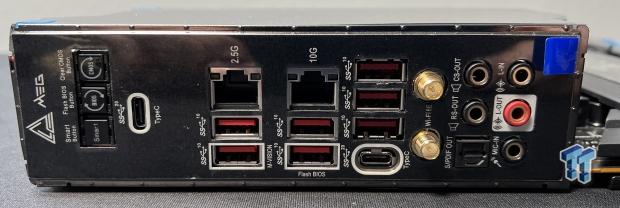
The rear I/O includes a host of buttons up top that allow you to clear CMOS and flash BIOS if needed. Moving down, we have what we assume is DP support via USB-C, perhaps on both ports. We then run into seven USB 3.2 Type-A and both RF45 LAN ports; 2.5Gbe and 10Gbe. Towards the bottom, we have the WiFi6e connections and analog audio outputs.
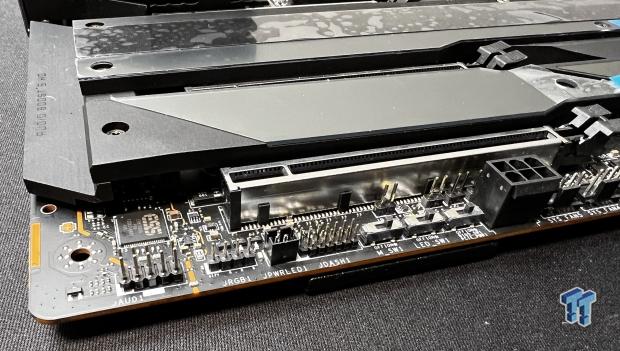
Across the bottom of the board, we have several switches for overclocking and a 6-pin additional power connection.
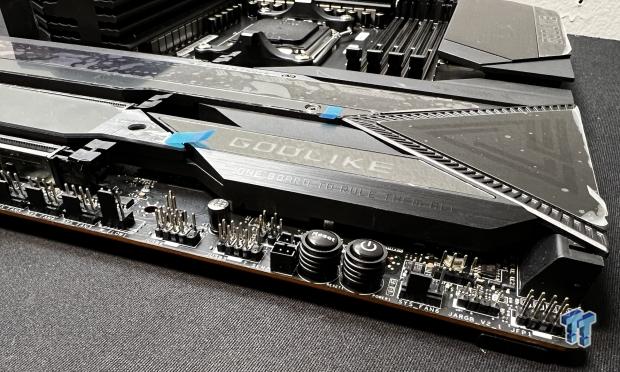
On the far end, we pick up the power and reset buttons, followed by fan headers and front panel chassis connections.
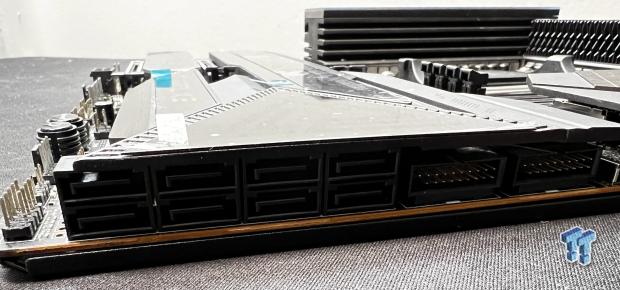
Around the edge, MSI has tucked away these connections under the heatsink awning. These include eight SATA and two USB 3.2 internal headers.
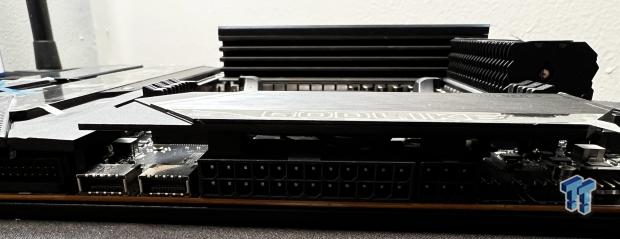
Getting to the top of the board, we have both 6-pin and 24-pin connections and two more USB 3.2 headers.
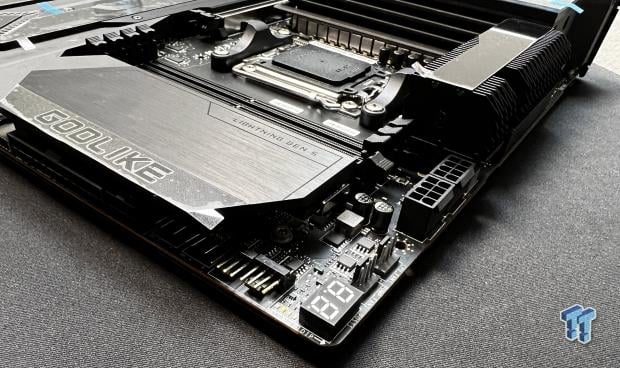
Across the top of the board, we have the debug LED and two fan headers. 8-pin power inputs have been placed here as well.
UEFI, Software and Test System
UEFI
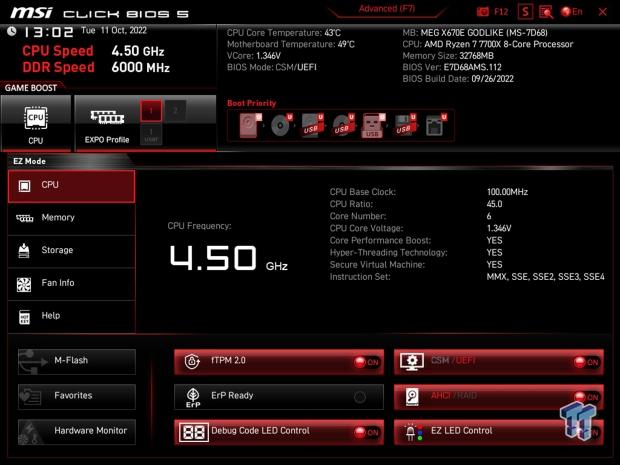
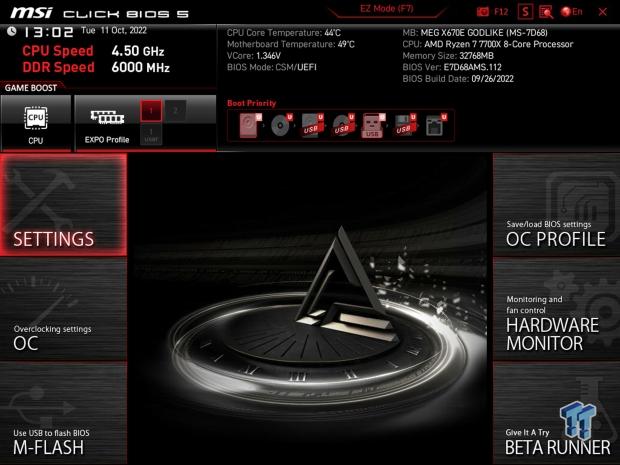
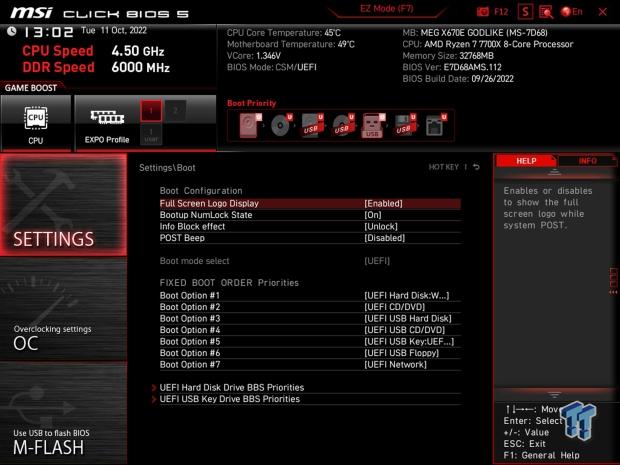
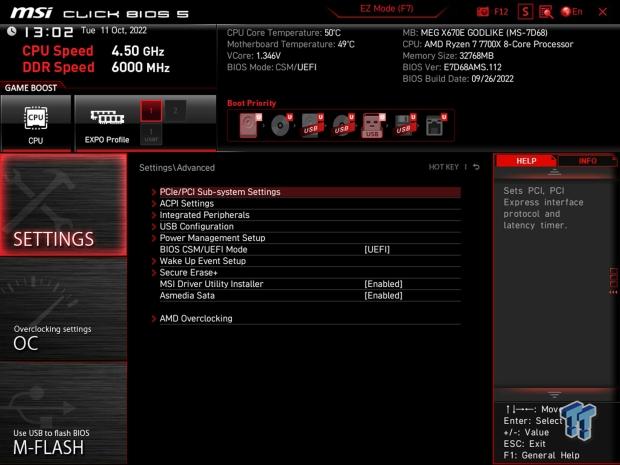
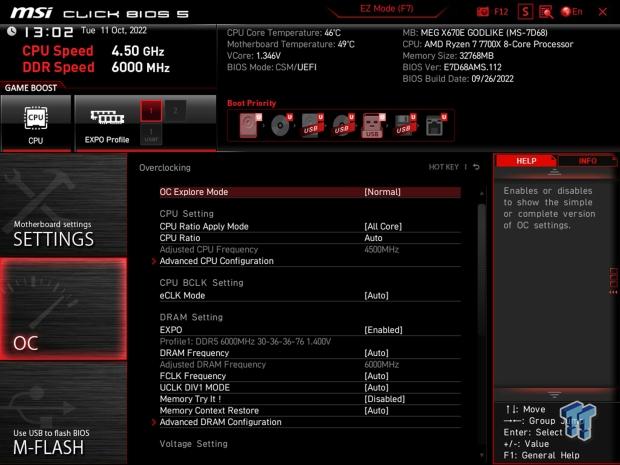
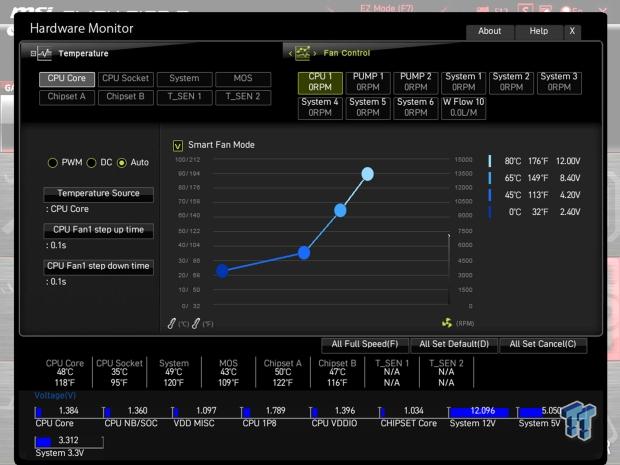
MSI's Click BIOS has stayed with X670E boards, giving consumers a familiar interface for GODLIKE when tuning their new Zen 4 system. EZ Mode includes a complete board overview with abilities to enable EXPO, change boot order, etc.
Other menus include the settings menu allowing configuration of integrated devices, including iGPU if your CPU has it. At the bottom of the menu, you can move into overclocking options, including manual tuning and PBO2 plus Curve Optimizer.
Motherboard Software
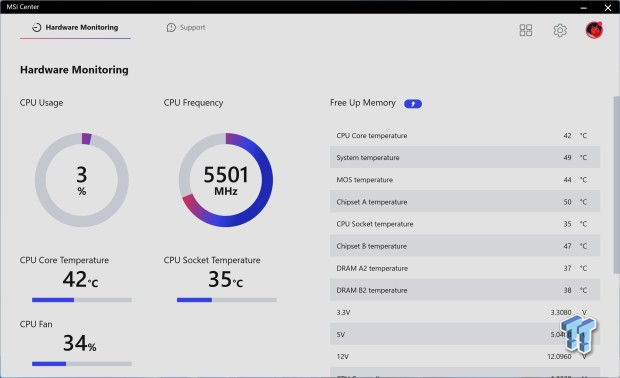
The software for this board is MSI Center, which allows you to monitor CPU usage alongside temperatures.
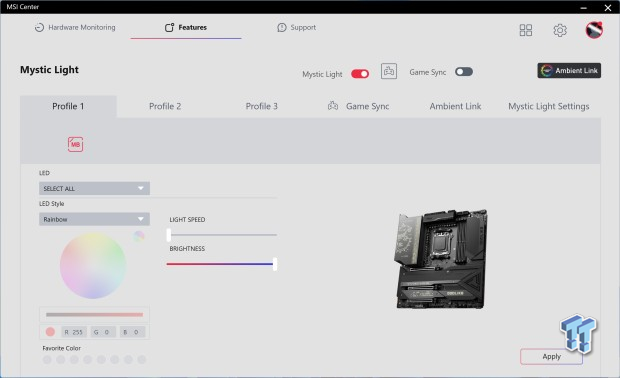
Mystic Light can also be controlled here, assuming the module is installed.
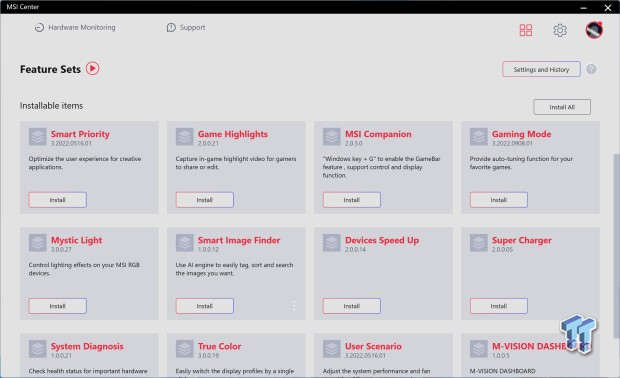
In addition, you can add modules to MSI Center.
Motherboard Testing Supporters
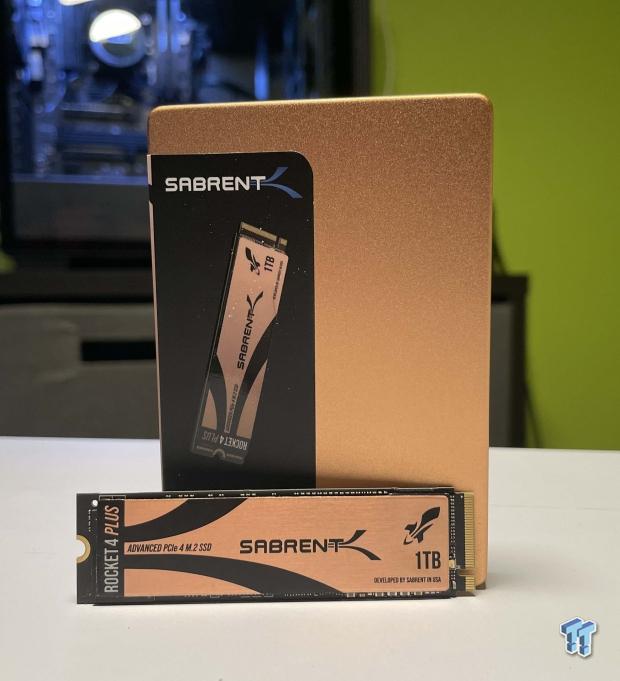
Sabrent supports our storage testing with the Rocket 4 Plus.
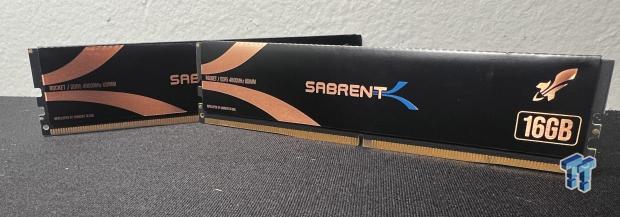
We crank up a set of Sabrent DDR5 for our testing, running DDR5 6000MHz at CL30 with 1.4v.
AMD Motherboard Test System
- CPU: AMD Ryzen 7 7700X
- RAM: Sabrent Rocket DDR5 4800MHz 32GB CL30 (buy from Amazon)
- GPU: NVIDIA GeForce RTX 3090Ti (buy from Amazon)
- OS Storage: Sabrent Rocket 4 Plus 1TB (buy from Amazon)
- Power Supply: AORUS P1200W PSU (buy from Amazon)
- OS: Microsoft Windows 11 (buy from Amazon)
Cinebench R23,Crossmark and AIDA64
Cinebench R23
Cinebench is a long-standing render benchmark that has been heavily relied upon by both Intel and AMD to highlight their newest platforms during unveils. The benchmark has two tests, a single-core workload utilizing one thread or 1T and a multi-threaded test that uses all threads or nT of a tested CPU.
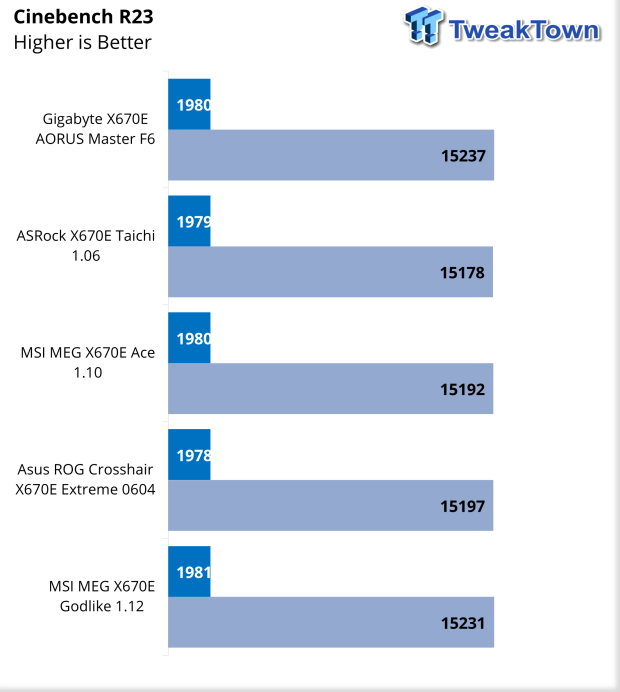
The GODLIKE was tested with BIOS 1.12 for this review. This offered up a score of 1981 in single thread R23 and 15231 nT.
CrossMark
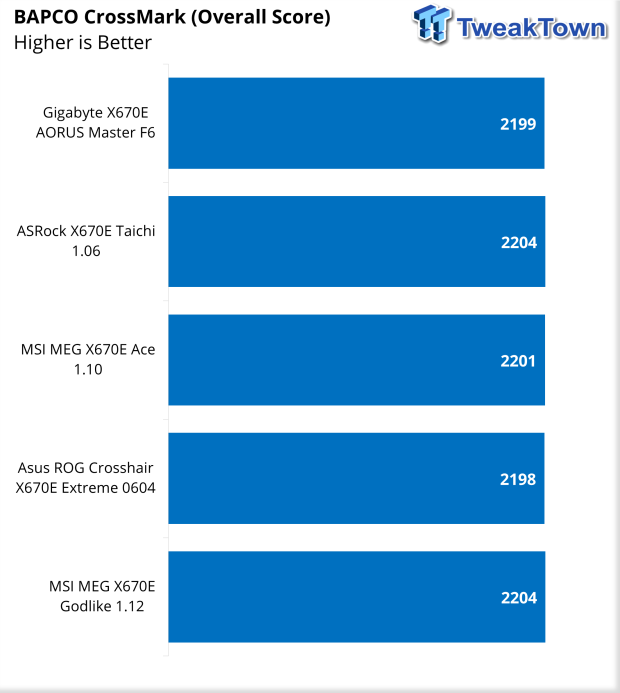
CrossMark landed us an overall of 2204.
AIDA64 Memory
AIDA was recently updated to version 6.6, which improved performance in both AES and SHA3 workloads.
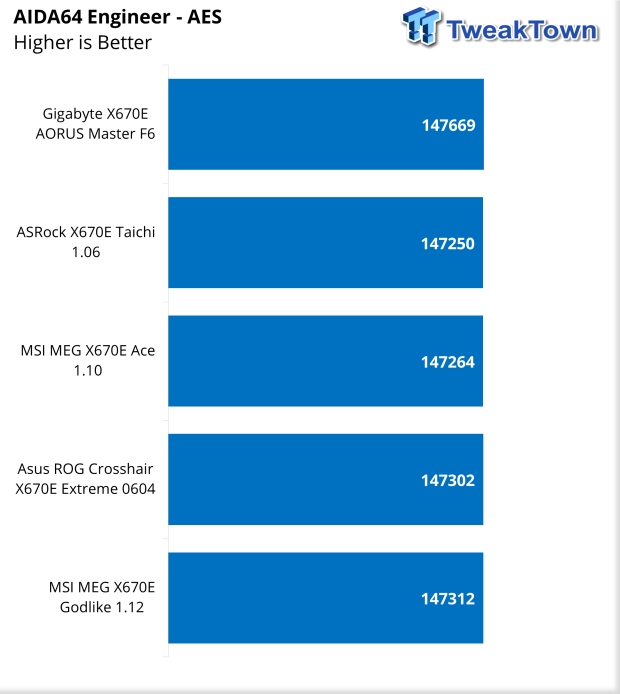
In AES, we picked up 147312 with the GODLIKE.
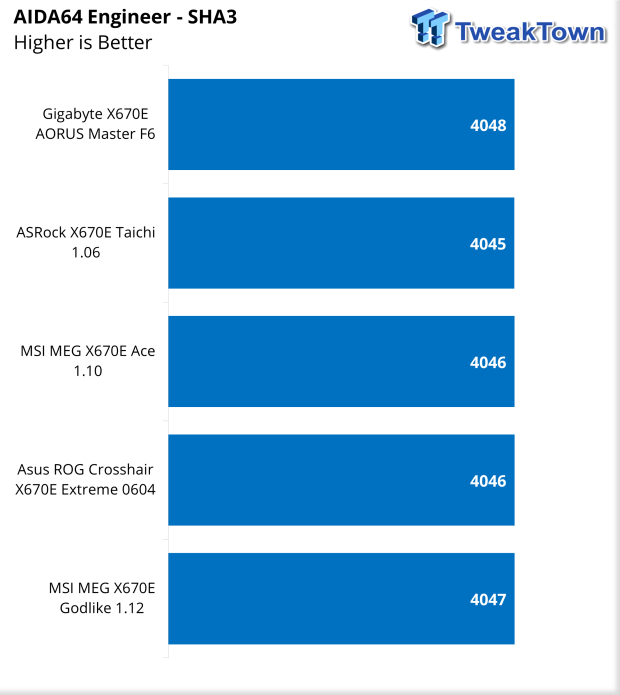
SHA3 tapped in at 4047.
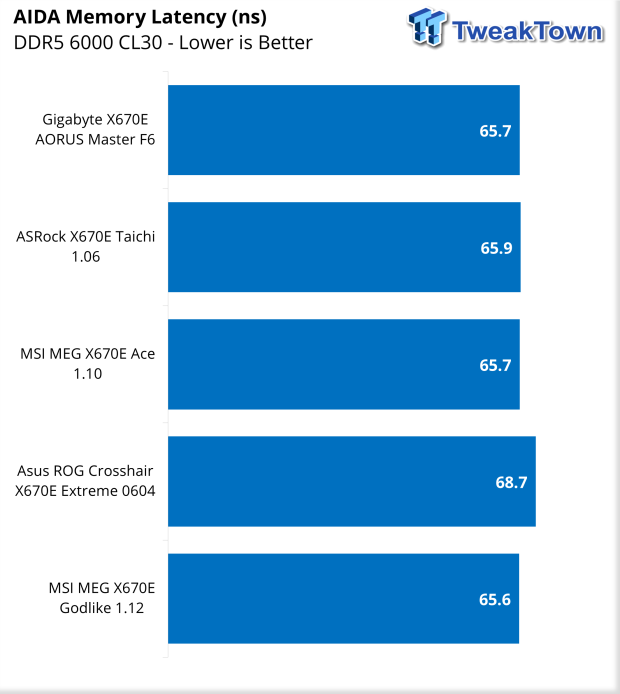
Memory latency was on par with some of the better boards in our charts; the GODLIKE comes in at 65.6ns.
UL Procyon,3DMark, and CrossMark Benchmarks
UL Procyon Suite
The UL Procyon Office Productivity Benchmark uses Microsoft Office apps to measure PC performance for office productivity work.
The Photo Editing benchmark uses Adobe Lightroom to import, process, and modify a selection of images. In the second part of the test, multiple edits and layer effects are applied to a photograph in Adobe Photoshop.
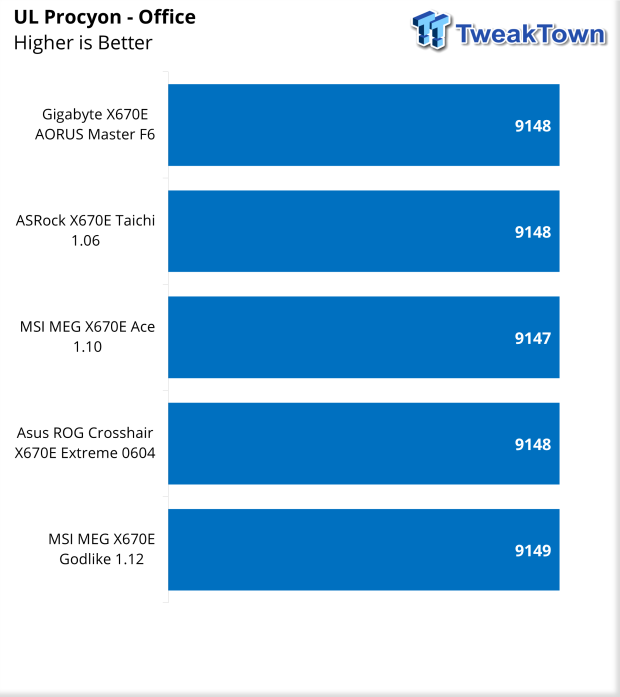
Procyon gave us a score of 9149 for Office.
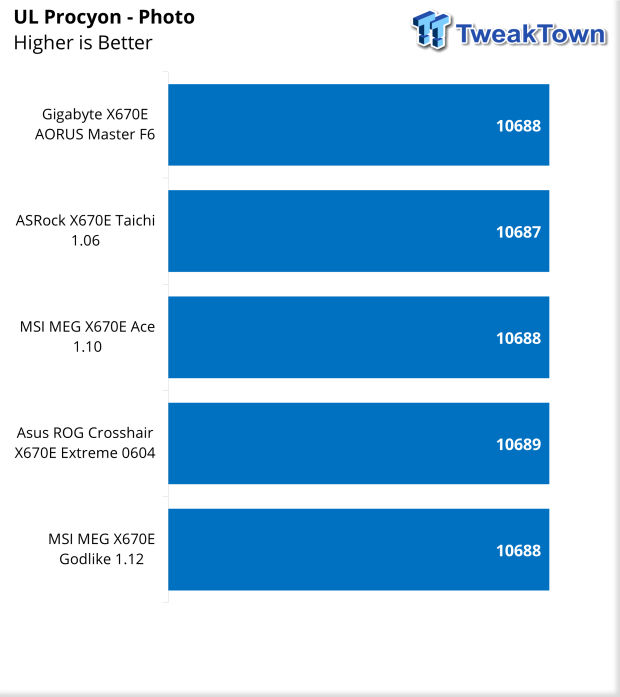
Photo Editing came in at 10688.
3DMark
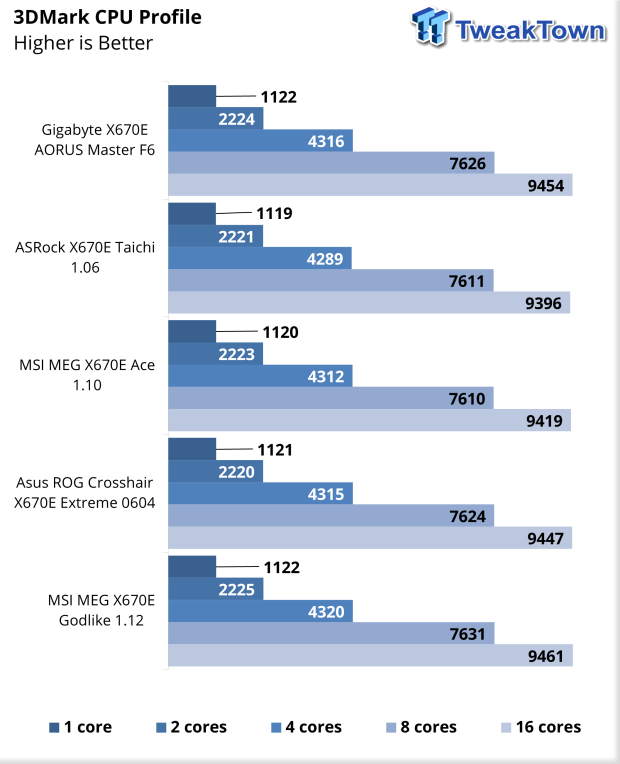
Starting with CPU Profile, the GODLIKE offered 1122 in single thread and 9461 at sixteen threads.
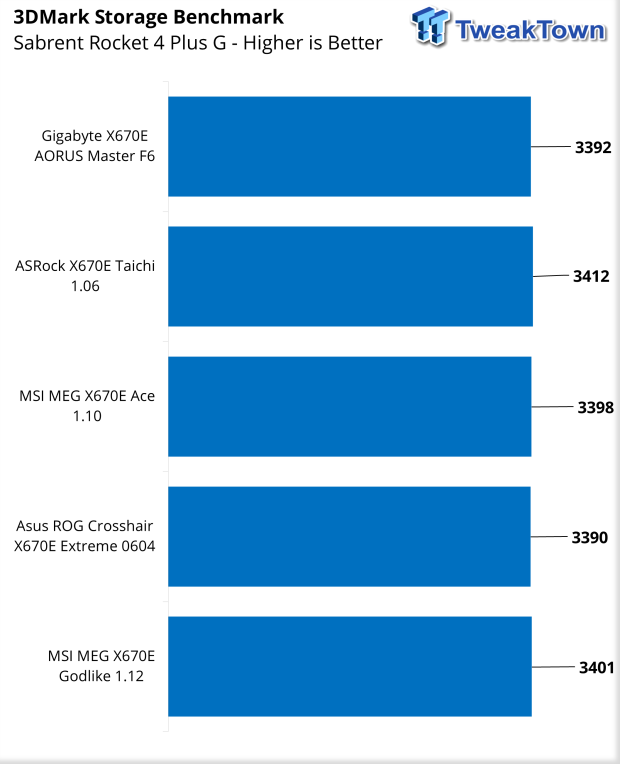
Flipping over to storage, we see a 3DMark score of 3401 from the GODLIKE.
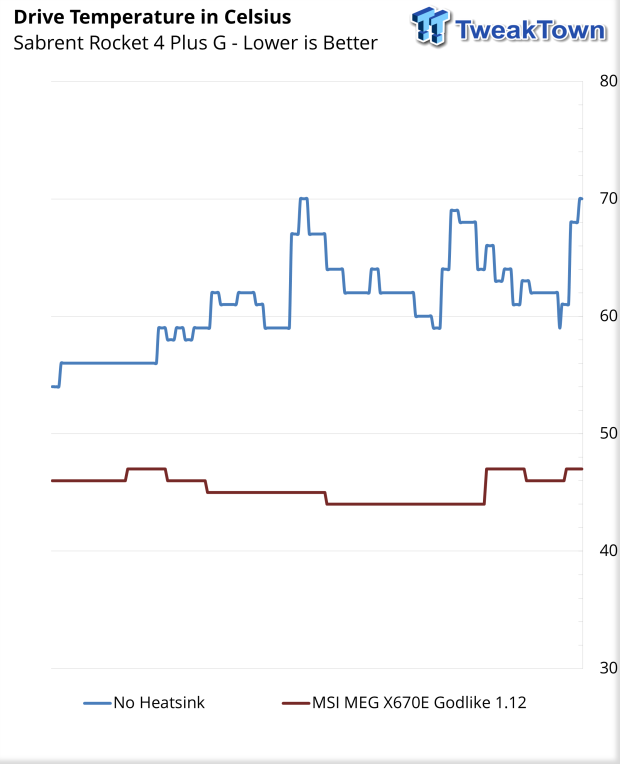
During our storage benchmark testing above, we monitor the temperatures of the Rocket 4 Plus to see how well the motherboard handles the heat load. This will be a crucial part of these boards after Gen5 drives are released with increased heat output.
The GODLIKE did well in this test, the Rocket 4 Plus seemed to hold a temp of 47c throughout testing.
Gaming Benchmarks and Final Thoughts
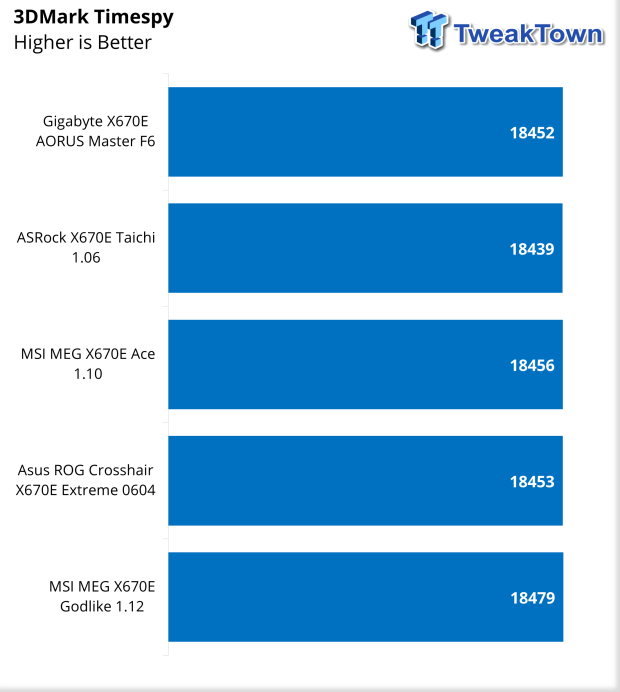
Timespy landed at 18479 with our 3090 Ti.
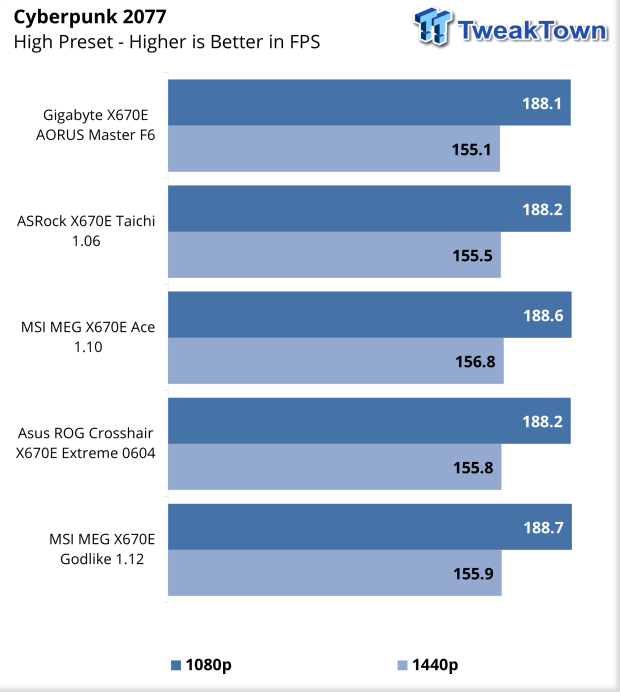
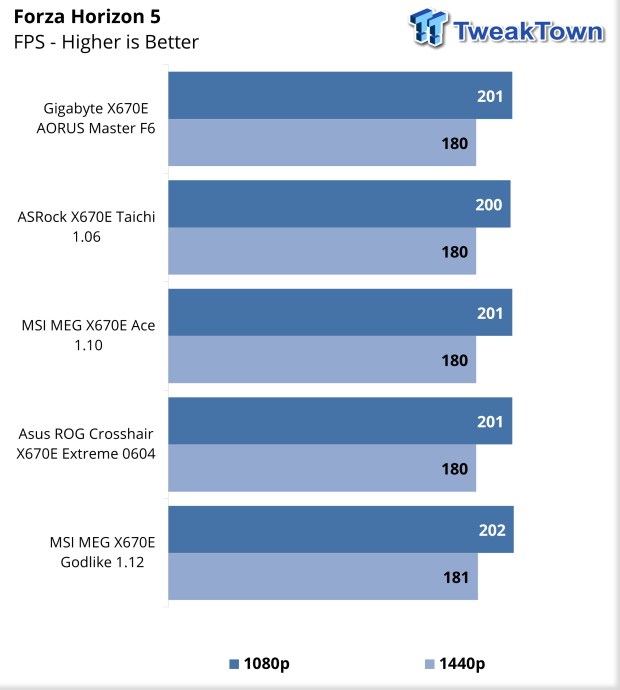
Gaming tests include both Forza Horizon 5 and Cyberpunk 2077. We evaluate both 1080p and 1440p resolutions.
Starting with Cyberpunk, the GODLIKE picked up a solid 188 FPS at 1080p, which moved to 155 FPS at 1440p. For Forza, we saw 201 FPS at 1080p and 180 FPS at 1440p.
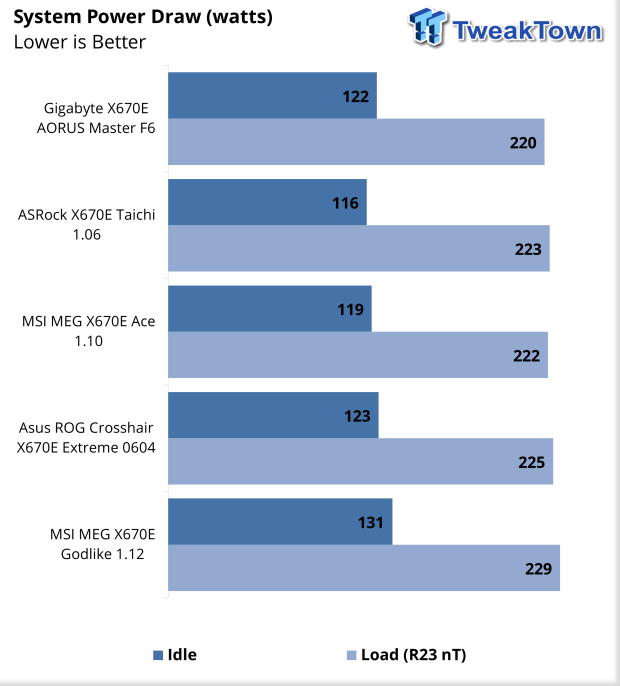
For those interested in power numbers from the tested board.
Final Thoughts
As I mentioned in the X670E ACE review, the X670E GODLIKE isn't a "spec monster" this time around like it has been in the past. Compared to the X670E ACE, the ACE has better rear I/O connectivity with more USB 3.2 and 10G, while GODLIKE has a similar setup with added 2.5Gbe.
That said, neither platform offers USB4 connectivity, and neither platform forces you into a new cable/dongle arrangement if you want to use your Zen 4 CPUs integrated graphics.
In testing, the GODLIKE did well. We noted overall consistency compared to previously tested motherboards, starting with R23. This gave us a 1981 single-thread score alongside its 15231 nT score. Overall, in the few points that go either way, this put GODLIKE above several boards.
The same scenario was present in CrossMark, with the GODLIKE offering 2204, top in our charts with the Taichi. Procyon Office and Photo both showed identical performance to other board platforms in our charts, with scores landing at 9149 and 10688, respectively. In gaming, the GODLIKE did very well in Cyberpunk, showing a solid 188 FPS paired with our 3090 Ti.
In closing, the MEG X670E GODLIKE is a fantastic board, with the big drawback being the price. MSI tries to offset this by adding 2.5Gbe to the board and additional overclocking controls. This board even has a separate M-Vision touchscreen that allows you to manage and control the board outside the BIOS or Windows.
All that said, the $1299 MSRP is a hard sell for me and should only be considered if you are an enthusiast that truly wants the extra controls the M-Vision Touch panel offers or the spectacle of owning a GODLIKE board.




